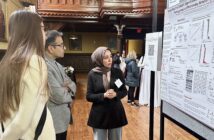An integrated clerkship provides students with new insight into their patients’ lives.
During my first few weeks as a third-year student on the medicine wards, we admitted a patient I’ll call R. She had multiple myeloma. When I first met R, she was sitting in her hospital bed reading the sports section of the newspaper. She had a cast on her right arm. Despite feeling sick and weak, she was smiling. She told me the Red Sox were her favorite team, and she wanted to be sure to keep up with the scores even when she was in the hospital. She had even chosen a red cast in support of her team.
I looked forward to visiting her and her husband every morning. During the weeks she was hospitalized, her stomach was bleeding and we could not determine its etiology. There were times our team thought we may not figure it out in time to help her recover. With the help of my attending, R and I had a conversation about her end of life goals. What is important to you? How do you define a “good death”? What do you want to happen before you leave this earth? She responded, “I want to be home and feel my dog sleeping in my lap again.”
Throughout the next few weeks, R had a partial gastrectomy to stop the bleeding. Although she improved and was able to leave the hospital to a rehabilitation center, new problems arose. Her right arm was healing, but a new bone lesion appeared in her left. Her delicate femur fractured just from sitting down on the toilet.
As part of the longitudinal integrated clerkship (LIC), I continued to follow R throughout my third year. During the LIC, medical students follow a panel of patients throughout the year, seeing the continuum of total health from outpatient appointments and hospitalizations to personal crises and changes in their social histories. It allows students to see how health unfolds for patients, and become advocates for them as they navigate the complex health care system.
I was with R as she prepared for surgery to fix her femur. I accompanied her to a radiation appointment, where she received palliative treatment for bone pain. I was able to be with her before and during a subsequent surgery to fix her left arm. I visited her during a dialysis session, one of the three she goes to every week. Her husband updated me every step of the way.
Finally, at the end of August, R was able to go home. Before she and her husband left for Florida for the winter, I paid them a visit. It was a very special feeling to see R in her own home, her dog by her side, just as she had wished.
A few days before Christmas, I got an email from R’s husband. It had a video of her walking several steps on her own, with a walker, and then sitting down in a chair, smiling as always, dog at her side. In the six months I had known her, I had never seen her walk on her own. Those small steps represented one of the most special moments in my medical training.
In the LIC, I learned a lot about each field of medicine; I gained more knowledge than I thought possible. But R helped me learn something more abstract, about the power of remaining optimistic and hopeful in the face of the enormous adversity of disease that, as health care providers, we easily lose sight of.
To this day I get regular updates about R’s health, the obstacles that present themselves, and her continual resolution to push past them. I am convinced her recovery from these obstacles is due in large part to her tenacity and positivity. I am grateful to the longitudinal integrated clerkship for giving me the opportunity to learn so much from R, and witness the way health care extends from the hospital to impact the smallest, most intimate and important parts of our patients’ daily lives.



